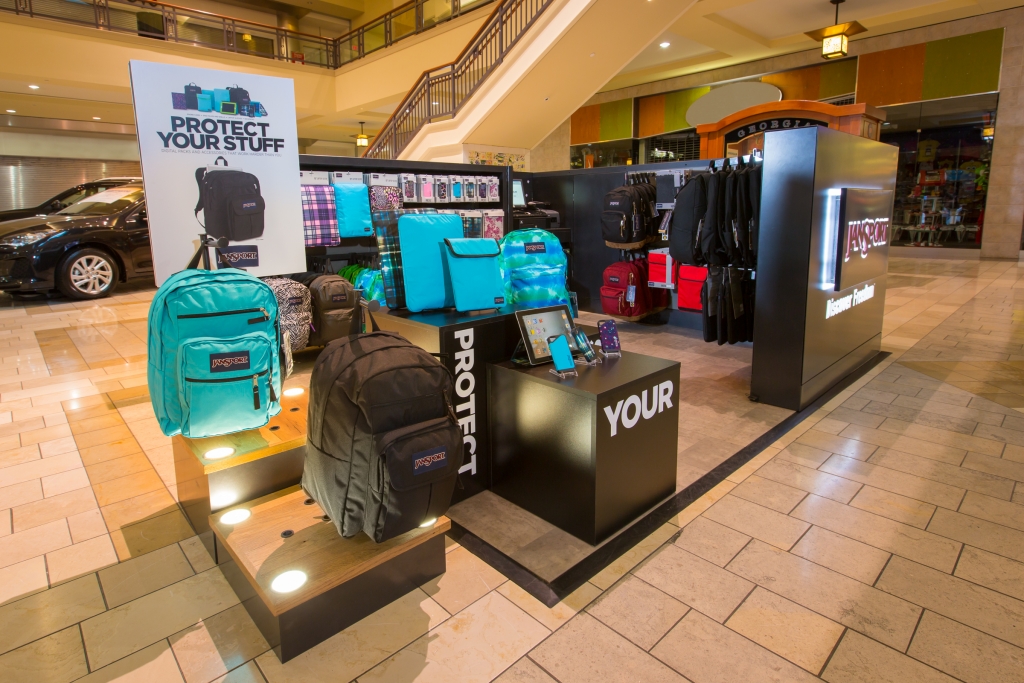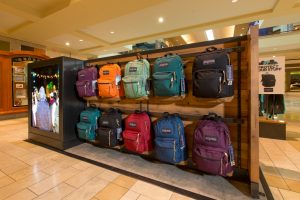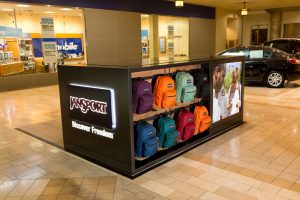Call it “The Planet of the Brands.”
After a destructive catastrophe caused by man rendered the retail landscape desolate, a new order has emerged with a new, dominant species.
And with a new language, too. Pop-up stores. Vendor shops. Branded concepts. Merchandise kiosks.
As traditional retailing reacted to the recession with store closings, consolidations and smaller footprints, individual consumer brands have grabbed the reins of retail innovation. The brands are using space design, merchandise presentation and fixture systems to establish and maintain their identity in a crowded, competitive world dominated by shoppers with the entire Internet at their fingertips.
So it seems appropriate that judges chose, as the fixture of the year in the 2013 Association for Retail Environments (A.R.E) retail design awards, a 100-square-foot merchandise kiosk designed to sit in the aisle of a mall by day – and to fold up for locked storage by night.
The kiosk was designed and built for JanSport, the backpack brand that is a division of VF Corp. (San Leandro, Calif.), by Twenty Four 7 (Portland, Ore.), to give it a noticeable retail presence in a compact space. It was rolled out last year in the Mall of Georgia (Buford, Ga.).
Advertisement
It’s a clean and modern blend of powdercoated metal and reclaimed wood, with backlit lifestyle graphics and glowing brand signage that seems to shine down the hall.
Surprising for such a small footprint, there’s plenty of room for shoppers to enter the environment, move around and interact with JanSport associates. And, perhaps most importantly in this do-more-with-less world, there’s an abundance of merchandise opportunity.
This is not to suggest that 21st Century retailing is headed in a shop-in-a-box direction. But it does show the innovation that must be brought to the table if brands are to establish their identities in all realms of retailing, whether it’s their own stores, branded concept shops, individual departments, single fixtures and racks or a kiosk in the middle of a crowded mall.
“We all have our stories to tell,” says Bob Higgins, vp, global real estate, for Fossil Inc. (Richardson, Texas), one of the A.R.E. judges. “And we’re all looking for that way to reach out and talk to the busy shopper as she navigates the crowded retail world.”
About the JanSport kiosk, Higgins calls it “an ingenious solution for how to speak to customers. It brands Jansport in a positive way, and fulfills a number of any brand’s objectives: First, it’s very branded; second, there’s good density of merchandise, but not just stuffed with goods; and it seems very well-thought-out and sophisticated.”
And in a comment that speaks to nearly every U.S. brand’s challenge to be an international presence, Higgins says “it would work anywhere in the world.”
Advertisement
Most big consumer brands no longer confine their marketing strategies to urban U.S. centers or regions of the country. Anyone anywhere with an iPad can investigate and become familiar with just about any brand, opening up the brands’ international possibilities for first, a kiosk in a mall, followed by distribution into a foreign big box or department store and, eventually, its own stores or a partnership with a local brand.
So the onus, says Higgins, is on consistency. “The ethos of customer interaction at Fossil is called ‘Welcome Home,’ ” he says. “No matter what the retail environment or where it is in the world, we’re welcoming the customer into our home for an intimate experience.”
That creates a retail intent of appearing residential, with lots of natural materials – wood floors and fixtures, stone walls, cork, grasscloth.
Since so much of Fossil’s merchandise – watches, handbags, charms, wallets, jewelry – is small, the fixtures must be designed to highlight the individual items without seeming overwhelmed by the density of choices. “It’s important to have enough product on the sales floor to meet our goals,” Higgins says, “but we also want it to be a comfortable, easy shopping experience.”
Even when the space in question is a smaller, self-contained concept shop, “We always strive for one brand/one image,” he says. “We want to look the same in the department stores as we do in our own stores.”
That includes the Watch Station and Scoggins stores, which Fossil also owns.
Advertisement
Few consumer brands have achieved that international brand uniformity as well as Nike (Beaverton, Ore.). “A clear consistency to the brand is pretty much a hallmark of the Nike culture,” says retail design director Marc Riera, another A.R.E. judge. “It’s what we stand for – grounded in the world of innovation and also of personal characteristics like excellence, effort, competing, being your best. As a result, it’s reflected in everything we do – product quality, marketing, advertising, events promotions, community relations and presentation at the retail level, whether that’s at a Nike store or at one of our retail partners.”
Many of Nike’s retail partners are big boxes like Dick’s Sporting Goods and The Sports Authority, so the need to stand out above the crowd is critical.
“We require functional flexibility, so we can come to market in the most robust manner, positioned in the best way in other people’s stores,” Riera says. “Modularity and scalability are key, so we look as good in 5000 square feet as in 250. That means the ability to adjust wall runs and heights, all on a module so everything can be adjusted. And we have to make sure all the attachments work for all packages, giving our presentation teams the tool kits to execute.”
Many brands have entered the multi-layered world of licensed manufacturing, as well, which means coordinating the concerns of several brands. Fossil, for example, manufacturers watches on a licensed agreement basis for fashion brands such as Michael Kors, Burberry, Armani, DKNY, Adidas, Tory Burch, Diesel and Karl Lagerfeld.
“They partner with us because of our expertise in watches,” says Higgins, “and we participate in the way these products are merchandised and fixtured because of our retailing expertise.”
Fossil is in the process of expanding that partnership. “We’re currently helping open Emporio Armani stores in Asia that sell jewelry and watches. In some cases, we’ll be developing the fixture systems, too.”
It’s all part of the complex story that today’s retailing has become – a brand within a brand, in a store within a store, coming soon to your neighborhood.


 Photo Gallery3 days ago
Photo Gallery3 days ago
 Headlines1 week ago
Headlines1 week ago
 Sector Spotlight2 weeks ago
Sector Spotlight2 weeks ago
 Headlines1 week ago
Headlines1 week ago
 Headlines4 days ago
Headlines4 days ago
 Headlines2 weeks ago
Headlines2 weeks ago
 Designer Dozen1 week ago
Designer Dozen1 week ago
 Headlines2 days ago
Headlines2 days ago




















